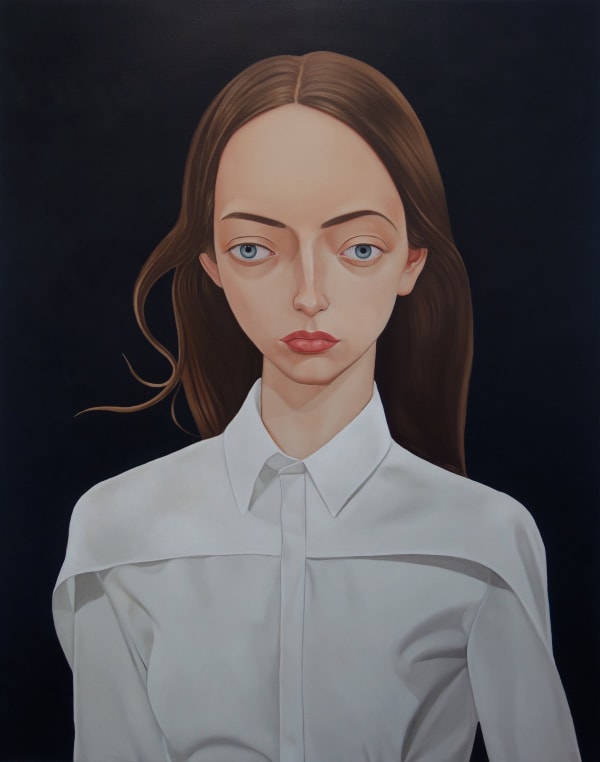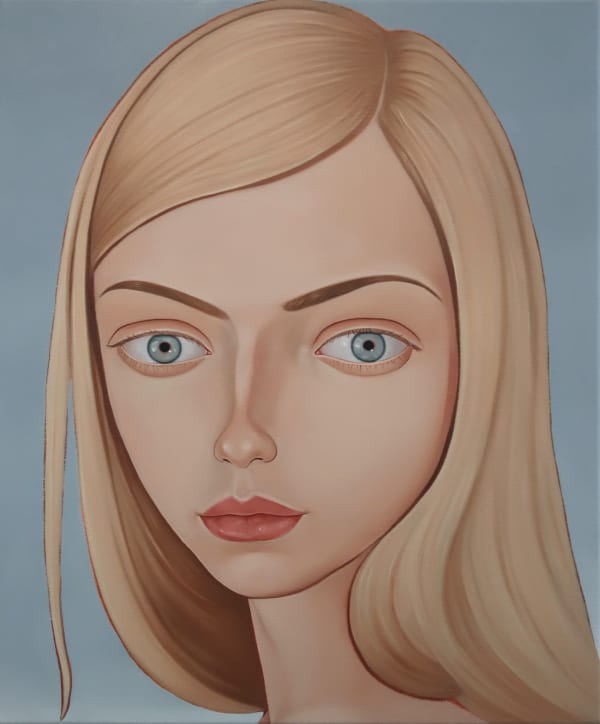Peter Stichbury: High Strangeness
“We have seen UFOs as classical spaceships for a long time, in accordance with science fiction in the forties and fifties…. psychic effects reported by witnesses are considered either as evidence of mental weakness or as electromagnetic side effects. Yet, as documentation improves we find out that the physical aspects of the phenomenon are as negotiable as its psychic effects.” — Jacques Vallée, astrophysicist, computer scientist and UFO/UAP researcher
Gallery Baton is delighted to announce High Strangeness, a solo exhibition by Peter Stichbury (b. 1969), from 27th October to 30th November in Apgujeong, Seoul. Stichbury has built a loyal audience in the US and Oceania, his portraits the visual accomplice to his elaborate, exhaustively researched case studies. This exhibition represents the first opportunity for the Asian and Korean audience to discover his work.
Stichbury has produced a series of works whose leitmotif is the psychological and physiological impact sustained by witnesses of mysterious aerial activity—known as Unidentified Aerial Phenomena (UAP). He questions the validity of most reports, deeming them contaminated by subjective interpretation, Government disinformation, or erroneous speculation. Many are deliberate hoaxes.
However a small proportion of cases which, while lacking tangible evidence, are unexplainable by conventional scientific methods, raise immeasurable speculation and mystery due to their ambiguous identity. It is these cases which spearhead his inquiry into this enigmatic phenomenon.
For Stichbury the concept of the UAP is synonymous with literary conventions where a central incident significantly influences both the plot and the life paths of characters. In a novel the core event is the centrum from which the Butterfly Effect emanates, influencing relations between characters, and between character and plot, even though they may appear unrelated at first glance. Interpreted through this lens, the UAP plays a parallel role in Stichbury’s practice—from the core UAP event ripple outwards complex psychological effects within witnesses. They often report subsequent absurd ‘high strange’ parapsychological, physical and psychic experiences. These can include missing time, temporary paralysis, disorientation, synchronicities, unexplained sunburn, and Klieg conjunctivitis.
Since 2014 Stichbury has been grappling with this subject, his fascination sparked by an experience in childhood of an object he could not identify moving slowly across the midday sky above him. Two previous museum shows on the subject, at La Casa Encendida, Spain in 2015, and Nevada Museum of Art in 2016–2017, have firmly established UAP as the current thematic focus of his practice.
Rigorously researching media material, declassified Government documents from several nations, and video footage, the artist pays particular attention to photographic data, academic and Government reports, and video footage of individuals in their 20s and early 30s. He perceives a purity in this age group which he believes renders them a relatively uncontaminated vessel for the strange occurrences they embody.
The fragile beauty of Stichbury’s figures contrasts with their discomforting, haunted gaze. This awkward juxtaposition points to a rupture in their accepted assumptions of what is real, as a result of their UAP encounter—a loss of belief in the consensus reality decided upon by humankind. His employment of exaggerated realism increases this impression of unreality and reveals further the internal disturbance of the characters.
The combination of Stichbury’s perceptive inquiry, exceptional painting skill and personal childhood experience, which although faint, still remains in his memory, have produced a series which functions as a personal archive delivered via a complex theme and compelling aesthetic. This exhibition will attempt to share the artist’s journey and also offer viewers the opportunity to explore the UAP witness cases Stichbury has found so engrossing.
Born in New Zealand, Peter Stichbury graduated from University of Auckland in 1997. He won the prestigious New Zealand art prize the Wallace Art Award in the same year. He has been presenting his work in leading international art institutions since, including Museum of New Zealand, Nevada Museum of Art, USA, La Casa Encendida, Spain, and Christchurch Art Gallery, New Zealand. Reviews of his work are published in several major art journals including Artforum and Modern Painters.
-
 Peter StichburyAurora Fernandes, Belem, 1977, 2017
Peter StichburyAurora Fernandes, Belem, 1977, 2017 -
 Peter StichburyLynda Jones, 1979, 2017
Peter StichburyLynda Jones, 1979, 2017 -
 Peter StichburyFather William Gill, 2016
Peter StichburyFather William Gill, 2016 -
 Peter StichburyMrs Jessie Roestenberg, 1954, 2017
Peter StichburyMrs Jessie Roestenberg, 1954, 2017 -
 Peter StichburyLiliane Fatima Silva, 1996, 2017
Peter StichburyLiliane Fatima Silva, 1996, 2017 -
 Peter StichburyRay Bowyer, 2007, 2017
Peter StichburyRay Bowyer, 2007, 2017 -
 Peter StichburyHella Hammid remote viewing an elephant skeleton in a museum, 10:10am, 1983, 2017
Peter StichburyHella Hammid remote viewing an elephant skeleton in a museum, 10:10am, 1983, 2017 -
 Peter StichburyHella Hammid remote viewing an elephant skeleton in a museum, 1983, 2017
Peter StichburyHella Hammid remote viewing an elephant skeleton in a museum, 1983, 2017 -
 Peter StichburyGlynda Nickerson (Dr John Mack session), 2017
Peter StichburyGlynda Nickerson (Dr John Mack session), 2017 -
 Peter StichburyIngo Swann remote viewing the far side of the moon, 2017
Peter StichburyIngo Swann remote viewing the far side of the moon, 2017











